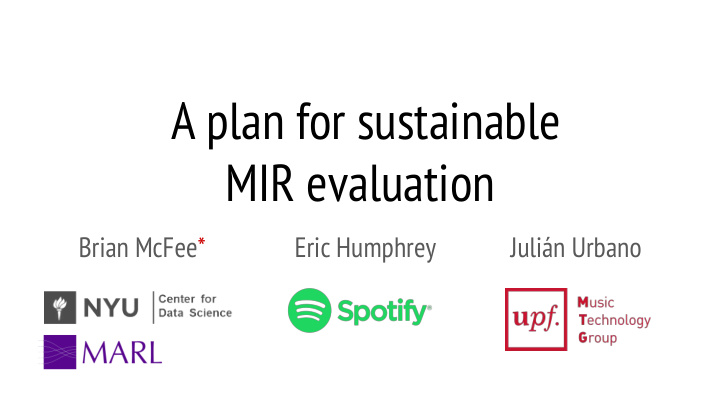



A plan for sustainable MIR evaluation Brian McFee* Eric Humphrey Julián Urbano
Hypothesis Experiment (model) (evaluation) Progress depends on access to common data
We’ve known this for a while Many years of MIREX! ● Lots of participation ● It’s been great for the community ●
Scientists Code MIREX machines (i.e., you folks) (and task captains) Results MIREX (cartoon form) Data (private)
Evaluating the evaluation model We would not be where we are today without MIREX.
Evaluating the evaluation model We would not be where we are today without MIREX. But this paradigm faces an uphill battle :’o(
Costs of doing business Computer time ● Human labor ● Data collection ●
Costs of doing business Computer time ● Annual sunk costs (proportional to participants) Human labor ● Data collection ● Best ! for $ *arrows are probably not to scale
Costs of doing business Computer time ● Annual sunk costs (proportional to participants) Human labor ● The worst thing that could happen is growth! Data collection ● Best ! for $ *arrows are probably not to scale
Limited feedback in the lifecycle Hypothesis Experiment (model) (evaluation) Performance metrics (always) Estimated annotations (sometimes) Input data (almost never)
Stale data implies bias https://frinkiac.com/caption/S07E24/252468
Stale data implies bias https://frinkiac.com/caption/S07E24/252468 https://frinkiac.com/caption/S07E24/288671
Inefficient distribution of labor ● The current model is Limited feedback ● unsustainable Inherent and unchecked bias ●
What is a sustainable model? Kaggle is a data science evaluation community (sound familiar?) ● How it works: ● Download data ○ Upload predictions ○ Observe results ○ The user-base is huge ● 536,000 registered users ○ 4,000 forum posts per month ○ 3,500 competition submissions per day (!!!) ○
What is a sustainable model? Kaggle is a data science evaluation community (sound familiar?) ● How it works: ● Download data ○ Distributed computation. Upload predictions ○ Observe oresults ○ The user-base is huge ● 536,000 registered users ○ 4,000 forum posts per month ○ 3,500 competition submissions per day (!!!) ○
Open content Participants need unfettered access to audio content ● Without input data, error analysis is impossible ● Creative commons-licensed music is plentiful on the internet! ● FMA: 90K tracks ○ Jamendo: 500K tracks ○
Distributed computation ● The Kaggle model is Open data means clear feedback ● sustainable Efficient allocation of human effort ●
But what about annotation?
Incremental evaluation [Carterette & Allan, ACM-CIKM 2005] Which tracks do we annotate for evaluation? ● None, at first! ○ Annotate the most informative examples first ● Beats: [Holzapfel et al., TASLP 2012] ○ Similarity: [Urbano and Schedl, IJMIR 2013] ○ Chords: [Humphrey & Bello, ISMIR 2015] ○ Structure: [Nieto, PhD thesis 2015] ○
Incremental evaluation [Carterette & Allan, ACM-CIKM 2005] Which tracks do we annotate for evaluation? ● None, at first! ○ Annotate the most informative examples first ● Beats: [Holzapfel et al., TASLP 2012] ○ Similarity: [Urbano and Schedl, IJMIR 2013] ○ This is already common practice in MIR. Chords: [Humphrey & Bello, ISMIR 2015] ○ Let’s standardize it! Structure: [Nieto, PhD thesis 2015] ○
Disagreement can be informative F#:7 F#:maj https://frinkiac.com/caption/S06E08/853001
1. Collect CC-licensed music 2. Define tasks 3. ($) Release annotated development set The evaluation loop 4. Collect predictions Human costs ($) directly produce data 5. ($) Annotate points of disagreement 6. Report scores 7. Retire and release old data
What are the drawbacks here? Loss of algorithmic transparency ● Potential for cheating? ● CC/PD music isn’t “real” enough ●
What are the drawbacks here? Loss of algorithmic transparency Linking to source makes results ● ● verifiable and replicable! What’s the incentive for cheating? ● Potential for cheating? ● Even if people do cheat, we still get the ● annotations. CC/PD music isn’t “real” enough For which tasks? ● ●
Proposed implementation details (please debate!) Data exchange ● OGG + JAMS ○ Evaluation ● mir_eval https://github.com/craffel/mir_eval ○ sed_eval https://github.com/TUT-ARG/sed_eval ○ Submissions ● CodaLab http://codalab.org/ ○ Annotation ● Fork NYPL transcript editor? https://github.com/NYPL/transcript-editor ○
A trial run in 2017: mixed instrument detection Complements what is currently covered in MIREX ● Conceptually simple task for annotators ● A large, well-annotated data set would be valuable for the community ● To-do: ● a. Collect audio b. Define label taxonomy c. Build annotation infrastructure d. Stretch goal: secure funding for annotators (here’s looking at you, industry folks ;o)
Get involved! This only works with community backing ● Help shape this project! ● Lots of great research problems here: ● Develop web-based annotation tools ○ How to minimize the amount of annotations ○ How to integrate disagreements over many tasks/metrics ○ Evaluate crowd-source accuracy for different tasks ○ Incremental evaluation with ambiguous/subjective data ○
Thanks! Let’s discuss at the evaluation town hall and unconference ! http://slido.com #ismir2016eval
Where do annotations come from? Crowd-sourcing can work for some tasks ● … but we’ll probably have to train and pay annotators for the difficult ones ○ This use of funding is efficient , and a good investment for the community ● Grants or industrial partnerships can help here ○ Idea: increase/divert ISMIR membership fees toward data creation? ○ Point of reference: annotating MedleyDB cost $12/track ($1240 total) ● $5 per attendee = a new MedleyDB each year ○
Incremental evaluation 2: estimate system performance system predictions estimated annotations S1 S2 S3 annotations A A D B A S1 = 0.4 ± 0.1 ? D E E E* S2 = 0.2 ± 0.2 F G G F F S3 = 0.2 ± 0.1 B B B F B ? E F G F* 1: estimate missing annotations
Recommend
More recommend